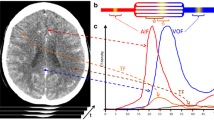Summary
The hypothesis was explored that patterns of ischaemic brain damage shown by CT may be of greater value in estimating the relevance of angiographic stenosis in the carotico-vertebral arteries in some patients than presenting clinical features. Five angiographic and six CT abnormalities were defined and charted independently in a blinded manner in 312 patients in whom clinical features and subsequent management were known. Charts were combined for statistical analysis. Statistically significant associations were found between two types of CT lesion and angiographic abnormalities, but these were present in only 18% of cases. The distribution of clinical features did not differe significantly within this subset compared to the whole population, from which it was concluded that the hypothesis was upheld. Furthermore significantly more patients in this subset were subjected to carotid endarterectomy, suggesting that management decisions may have been modulated by CT findings in some patients.
Similar content being viewed by others
References
Sandercock P, Molyneux AJ, Warlow C (1985) Value of computed tomography in patients with stroke: Oxfordshire Community Stroke Project. Br Med J 19: 193–197
Houser OW, Campbell JK, Baker AL Jr, Sandt TS (1982) Radiologic evaluation of ischaemic cerebrovascular syndromes with emphasis on computed tomography. Radiol Clin North Am 20: 123–142
Moseley I (1986) Diagnostic imaging in neurological disease. Churchill Livingstone, London
Awad L, Modic M, Little J, Furlan AJ, Weinstein M (1986) Focal parenchymal lesions in transient ischaemic attacks: correlation of computed tomography and magnetic resonance imaging. Stroke 17: 399–403
Zukowski AJ, Nicolaides AN, Lewis RT, Mansfield AO, Williams MA et al. (1984) The correlation between carotid plaque ulceration and cerebral infarction. J Vasc Surg 1: 782–786
Bogousslawsky J, Regli F (1984) Cerebral infarction with transient signs (CITS): do TIAs correspond to small deep infarcts in internal carotid artery occlusion? Stroke 15: 536–539
Graber JN, Vollman RW, Johnson WC et al. (1984) Stroke after carotid endarterectomy: risk as predicted by preoperative computerised tomography. Am J Surg 147: 492–497
Hutchinson EC, Yates PO (1957) Carotico-vertebral stenosis. Lancet I: 2–8
Schwartz CJ, Mitchell JRA (1961) Atheroma of the carotid and vertebral arterial systems. Br Med J 2: 1057–1063
Rodda RA (1986) The arterial patterns associated with internal carotid disease and cerebral infarcts. Stroke 17: 69–75
McGee DA, McPhedran RS, Hoffman HJ (1962) Carotid and vertebral artery disease. A clinicopathological survey of 70 cases. Neurology 12: 848–859
Grotta JC, Bigelow RH, Hu H, Hankins L, Fields WS (1984) The significance of carotid stenosis or ulceration. Neurology 34: 437–442
Thiele BL, Young JV, Chikos PM, Hirsch JH, Strandness DE (1980) Correlation of arteriographic findings and symptoms in cerebrovascular disease. Neurology 30: 1041–1046
Brown PB, Zwiebel WJ, Call GK (1989) Degree of cervical carotid artery stenosis and hemisphere stroke: duplex US findings. Radiology 170: 540–543
Thijssen HOM, Merx JL, Mostart JEJM, Thijssen MAO, Wong Chung R, Schoonder Waldt H, Keyser A (1988) Comparison of brachiocephalic angiography and IVDSA in the same groups of patients. Neuroradiology 30: 91–97
Pullicino P, Eskin J, Ketonen L (1983) Prevalence of Binswanger's disease. Lancet I: 939
Zeumer H, Schonsky B, Sturm KW (1980) Predominant white matter involvement in subcortical arteriosclerotic encephalopathy (Binswanger's disease). J Comput Assist Tomogr 4: 14–19
Inzitari D, Diaz F, Fox A et al. (1987) Vascular risk factors and leukoaraiosis. Arch Neurol 44: 42–47
Tomlinson BE, Corsellis JAN (1984) Arteriosclerotic or multiinfarct dementia. In: Hume Adams J, Corsellis JAN, Duchen LW (eds) Greenfields neuropathology, 4th edn. Edward Arnold, London, pp 982–986
Gamble CN (1986) Pathogenesis of hyaline arteriosclerosis. Am J Pathol 122: 410–420
Graham DI, Brierley JB (1984) Vascular disorders of the central nervous system. In: Hume Adams H, Corsellis JAN, Duchen LW (eds) Greenfields neuropathology, 4th edn. Edward Arnold, London, pp 152–235
Zimmerman RD, Fleming CA, Lee BC, Saint-Louis LA, Deck MDF (1986) Periventricular hyperdensity as soon by magnetic resonance: prevalence and significance. AJNR 7: 13–20
Kirkpatrick JB, Hayman LA (1987) White matter lesions in MR Imaging of clinically healthy brains of elderly subjects: possible pathological basis. Radiology 162: 509–511
Tsementzis SA, Hitchcock ER, Woolley JL (1984) Emission and transmission tomography of the brain in cerebrovascular disease. Surg Neurol 21: 385–390
Grigg M (1988) The significance of cerebral infarction and atrophy in patients with AF and TIAs in relation to internal carotid artery stenosis. J Vasc Surg 4: 215–222
Calandre L, Gomara S, Bermejo F, Millan JM, del Pozo G (1984) Clinical CT correlations in TIA, RIND and strokes with minimum residue. Stroke 15: 663–666
Ricotta JJ, Ouriel K, Green R, De Weese J (1985) Use of computerised cerebral tomography in selection of patients for elective and urgent carotid endarterectomy. Ann Surg 202: 783–787
Goldenberg G, Reisner TH (1983) Angiographic findings in relation to clinical course and results of computed tomography in cerebrovascular disease. Eur Neurol 22: 124–130
Levine RL, Lagreze HL, Dobkin JA, Tvrski PA (1988) Large subcortical hemispheric infarctions. Arch Neurol 45: 1074–1077
Donnan G, Tress BM, Bladin PF (1982) A prospective study of lacunar infarction using computerised tomography. Neurology 32: 49–56
Stevens JM, Barter S, Kerslake R et al. (1989) Relative safety of intravenous digital subtraction angiography over other methods of carotid angiography, and impart on clinical management of cerebrovascular disease. Br J Radiol 62: 813–816
Author information
Authors and Affiliations
Rights and permissions
About this article
Cite this article
Stevens, J.M., Barber, C.J., Kerslake, R. et al. Extended use of cranial CT in the evaluation of patients with stroke and transient ischaemic attacks. Neuroradiology 33, 200–206 (1991). https://doi.org/10.1007/BF00588218
Issue Date:
DOI: https://doi.org/10.1007/BF00588218




